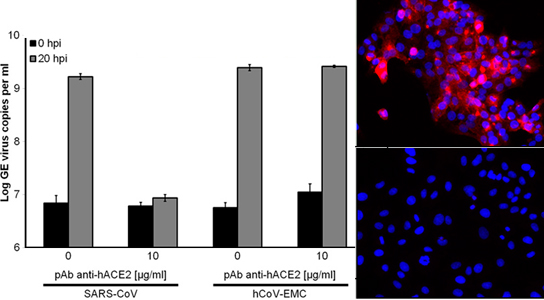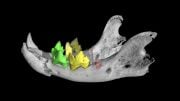
The hCoV-EMC virus could still enter bat cells (blue) even when the ACE2 receptor was blocked by antibodies (red). Studies in monkey kidney cells (left) also showed that blocking ACE2 prevented the entry of the SARS virus (top right) but not hCoV-EMC (bottom right). Credit: Marcel A. Müller and Christian Drosten/University of Bonn Medical Center, Germany
The novel coronavirus which was discovered this summer in the Middle East might infect more than just human patients. The pathogen is closely related to SARS, and it may also be able to infect pigs and a wide range of bat species.
The scientists published their findings in the journal mBio. The findings might help public health officials track the source of the outbreak and identify the role of wild animals and livestock in the spread of the virus.
The hCoV-EMC (human coronavirus-Erasmus Medical Center) was identified in the Erasmus MC in Rotterdam, the Netherlands, from a sample obtained from a 60-year-old Saudi. Cases have appeared in Qatar and Jordan, and researchers have confirmed nine infections, including five deaths. Several other cases are suspected, but these haven’t been confirmed.
The virus has been fully sequenced and its genome revealed that it is closely related to the SARS coronavirus. The SARS virus uses a receptor called ACE2 to open cells, which are found deep inside the human lung. If hCoV-EMC used the same receptor, researchers would be able to understand how the virus spreads and how to stop it.
The team engineered baby hamster kidney cells to express the human ACE2 receptor. The cells could be infected with the SARS coronavirus, but not hCoV-EMC. This led the scientists to conclude that hCoV-EMC doesn’t use ACE2 to get into cells. It’s yet unclear which receptor it uses.
Epidemiologists also wanted to know which species of animals hCoV-EMC was capable of infecting to keep it from spreading further, so they tested cells from humans, pigs and bats, the key natural reservoirs of coronaviruses. They found that hCoV-EMC could infect all of these cells.
Most coronaviruses come from bats, but once they jump to other species, they usually can never reinfect bat cells. This could mean that hCoV-EMC is unique in its ability and researchers believe it could still have come from a bat. Either way, they believe the new coronavirus can infect a wide range of species, so public health officials may have to start looking for infections and deaths in local wild animal and livestock populations.
Reference: “Human Coronavirus EMC Does Not Require the SARS-Coronavirus Receptor and Maintains Broad Replicative Capability in Mammalian Cell Lines” by Marcel A. Müller, V. Stalin Raj, Doreen Muth, Benjamin Meyer, Stephan Kallies, Saskia L. Smits, Robert Wollny, Theo M. Bestebroer, Sabine Specht, Tasnim Suliman, Katrin Zimmermann, Tabea Binger, Isabella Eckerle, Marco Tschapka, Ali M. Zaki, Albert D. M. E. Osterhaus, Ron A. M. Fouchier, Bart L. Haagmans and Christian Drosten, 11 December 2012, mBio.
DOI: 10.1128/mBio.00515-12









Be the first to comment on "Novel Coronavirus hCoV-EMC Infects Humans & Animals"